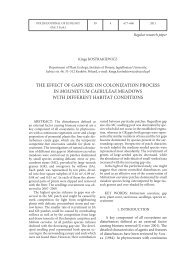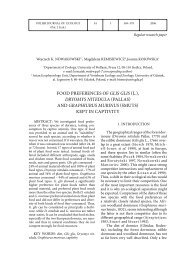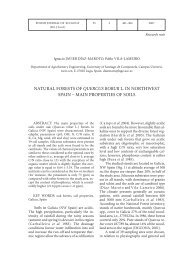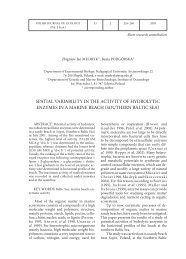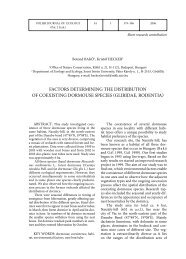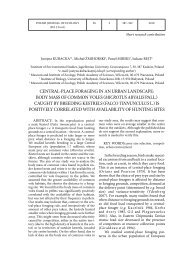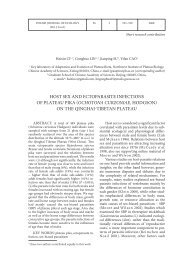SHORT-TERM EFFECTS OF PRESCRIBED FOREST FIRE ON SOIL ...
SHORT-TERM EFFECTS OF PRESCRIBED FOREST FIRE ON SOIL ...
SHORT-TERM EFFECTS OF PRESCRIBED FOREST FIRE ON SOIL ...
Create successful ePaper yourself
Turn your PDF publications into a flip-book with our unique Google optimized e-Paper software.
POLISH JOURNAL <strong>OF</strong> ECOLOGY<br />
(Pol. J. Ecol.)<br />
57 4 805–809 2009<br />
Short research conrtibution<br />
Olga GRABCZYŃSKA 1,3* , Izabella OLEJNICZAK 1 , Anna PRĘDECKA 2 , Stefan RUSSEL 3<br />
1<br />
Centre for Ecological Research, Polish Academy of Sciences, Dziekanów Leśny,<br />
05-092 Lomianki, Poland, *e-mail: olga_grabczynska@cbe-pan.pl (corresponding author)<br />
2<br />
The Main School of Fire Service, Civil Safety Engineering Faculty, Department of Safety Analyses<br />
and Prognosis, Słowackiego Street 52/54, 01-629 Warsaw, Poland<br />
3<br />
Warsaw University of Life Sciences, Faculty of Agriculture and Biology,<br />
Department of Soil Environmental Science, Nowoursynowska Street 166, 02-787 Warsaw, Poland<br />
<strong>SHORT</strong>-<strong>TERM</strong> <strong>EFFECTS</strong> <strong>OF</strong> <strong>PRESCRIBED</strong> <strong>FOREST</strong> <strong>FIRE</strong><br />
<strong>ON</strong> <strong>SOIL</strong> MITES (ACARI)<br />
ABSTRACT: Natural forest fires are considered<br />
as a part of natural ecosystem processes.<br />
Short-term effects of prescribed fire on densities<br />
and taxonomic diversity of soil Acari were studied<br />
in fresh pine mixed forest (“Biala” forest ) in the<br />
Mazovia region, Central-Eastern Poland. Three<br />
plots (size 1 m 2 ) of similar soil type and vegetation<br />
were selected for prescribed burning. Soil samples<br />
of an area of 10 cm 2 and the depth of 5 cm were<br />
collected in June 2005 – one day after the burning,<br />
60 days after the burning and 90 days after<br />
the burning. Samples were collected from within<br />
the border of the burned plots, from the border<br />
itself, as well as from the surroundings. Due to<br />
the burning, the density of Acari communities<br />
decreased from 11.5 × 10 3 ind. m -2 recorded in<br />
the surroundings to 3.2 × 10 3 ind. m -2 recorded<br />
in the burned plots. Values recorded within the<br />
burned plots after the fire differed significantly<br />
from those recorded on the border (P = 0.05) and<br />
in the surroundings (P = 0.0001). After 60 days,<br />
an increase in Acari abundance was observed in<br />
the burned plots (P = 0.02), becoming similar to<br />
that noted for the border of the plot and for the<br />
surroundings. After 90 days, there were no significant<br />
differences between the burned parts of the<br />
plots, their borders and the surroundings; however,<br />
generally decreased densities were observed,<br />
possibly due to the seasonal reason. The observed<br />
changes suggest the restoration of Acari community<br />
after disturbance.<br />
KEY WORDS: Acari, fire, forest, prescribed<br />
burning<br />
Natural forest fires – i.e. started by lighting<br />
– are considered a natural force involved<br />
in the ecosystem processes and having a significant<br />
evolutionary importance (B ond and<br />
Keeley 2005). Many organisms are adapted<br />
to survive them or to recolonize the disturbed<br />
areas (B engtsson 2002). Prescribed fires are<br />
used in forest management to reduce fire hazard<br />
and to create favourable conditions for<br />
plant development (Marshall 2000).<br />
Fire changes the structure and moisture of<br />
soil, decreasing the quantity of organic matter<br />
and leading to nutrient loss. It also influences<br />
the rate of organic matter decomposition. Extinction<br />
of vegetation after fire increases the<br />
rate of surface runoff as well as soil temperature<br />
(by blackening the soil surface). The sites<br />
suitable for recolonization had become deficient<br />
(Near y et al. 1999). Ecosystems can be<br />
affected by fire at diverse scales, ranging from<br />
days (short-term) to hundreds of years on the<br />
time scale, and from a single point to thousands<br />
of hectares on the spatial scale (Hardy<br />
2005).<br />
The function of soil microarthropod<br />
communities in the ecosystem is important<br />
journal 20.indb 805 2009-12-30 15:31:40
806<br />
Olga Grabczyńska et al.<br />
as – among others – they control the decomposition<br />
of litter (Blair et. al. 1992, S cheu<br />
and S chaefer 1998). Thus the impact of<br />
prescribed burning and wild-fire on these<br />
communities was broadly studied in many<br />
environments i.e.: grasslands (Lussenhop<br />
1976), Mediterranean phryganic ecosystem<br />
(Sgardelis and Margaris 1993), temperate<br />
(Dress and B oerner 2004) and boreal<br />
forests (Haimi et. al. 2000, Wikars and<br />
S chimmel 2001). The lethal temperature<br />
for almost all microarthropods is under<br />
40°C (Malmström 2008) but short-term<br />
response of microarthropods to fire can vary<br />
significantly and results of studies are often<br />
contrasted. Lussenhop (1976) reported no<br />
changes in abundance of microarthropods in<br />
short period after fire (up to 1 month), while<br />
Sgardelis and Margaris (1993) reported<br />
severe reduction in abundance of microarthropods,<br />
distinguished up to over 3 years.<br />
The presented study is a part of the complex<br />
investigations carried out by Department<br />
of Soil Environmental Science of Warsaw<br />
University of Life Sciences in cooperation<br />
with the Main School of Fire Service. The<br />
experiments were focused on the manner in<br />
which fire and fire-fighting techniques affect<br />
the organisms in forest soil.<br />
The aim of this study was to estimate the<br />
effect of prescribed fire upon the density and<br />
diversity of Acari. The experiment was conducted<br />
in “Biała Forest”, 60 km north-east<br />
from Warsaw, in fresh pine mixed forest with<br />
dominating podzol gley (pH 3.5) with fresh<br />
moder humus. In forest tree layer, Scots pine<br />
(Pinus sylvestris) was dominant, with numerous<br />
birches (Betula pendula), while in shrub<br />
layer – common juniper (Juniperus communis)<br />
and Frangula alnus were dominant. In<br />
herb layer, European blueberry (Vaccinium<br />
myrtillus) and Sheep’s Fescue (Festuca ovina)<br />
were most common.<br />
In June 2005, three plots, each 1 m 2 in<br />
size, with the same soil and vegetation, were<br />
randomly chosen. The prescribed fire lasted<br />
30 minutes, until total burn-out of litter and<br />
herb layer. The mean temperature of ground<br />
after fire was 377°C. The fire was extinguished<br />
with the fire-fighting substances Protektol<br />
SAT-10 and Roteor M. Both agents are waterbased<br />
and commonly used for extinguishing<br />
forest fires. The field experiments were assisted<br />
by a fire-brigade. The permission from<br />
Forest Inspectorate Ostrów Mazowiecka (letter<br />
N-24/12/05 from 2005.05.04) was received<br />
for this experimental burning.<br />
Environmental data recorded during<br />
study period – air temperature, air humidity<br />
and litter humidity – are presented in Table 1.<br />
Samples were collected thrice – in June,<br />
immediately after the burning, 60 days after<br />
the burning (August) and 90 days after the<br />
burning (September). The time of second<br />
sampling was chosen in order to allow Oribatida<br />
to complete at least one generation, i.e. at<br />
least 8 weeks (Walter and Proctor 2004).<br />
The samples were taken with a steel corer,<br />
from an area 10 cm 2 to the depth 5 cm. Ten<br />
samples were taken in each sampling plot<br />
and on each sampling occasion. In total, 90<br />
samples were taken from three experimental<br />
plots: 30 samples from burned plots (fire), 30<br />
from borders of burned plots (border) and 30<br />
from the surrounding area, at a distance of 1<br />
m from plot the borders (surroundings).<br />
The microrarthropods were extracted<br />
from the samples in Tullgren’s apparatus.<br />
Identification of Acari was based on Krantz’s<br />
(1978) key and Soil Biology Guide (Dindal<br />
1990). Wilcoxon non-parametric signedrank<br />
test and Kruskall-Wallis non-parametric<br />
analysis of variance were used.<br />
Diversity of community was calculated<br />
with the Shannon-Wiener index (H’). Statistical<br />
significance of differences in the H’ index<br />
values was checked with Hutcheson’s<br />
(1970) test.<br />
The density of Acari communities<br />
immediately after the fire within burned<br />
plots was the lowest from recorded densities<br />
and it was significantly different from<br />
those recorded for border (P = 0.05) and<br />
surroundings (P = 0.0001) (Fig. 1). 60 days<br />
after the burning, about three fold increase<br />
of Acari densities was noted in burned plots<br />
(P = 0.02), but there was no significant difference<br />
between all three parts of the plots.<br />
After 90 days, a decrease of densities in all<br />
parts was observed, but again there were no<br />
significant differences between recorded values<br />
(Fig.1).<br />
Oribatida were the dominating order during<br />
study period (Fig. 2). Their lowest participation<br />
rate was noted in borders, where Mesostigmata<br />
participation increased.<br />
journal 20.indb 806 2009-12-30 15:31:40
Influence of prescribed fire on soil Acari<br />
807<br />
m -2<br />
Fig. 1. Mean densities (± SE) of Acari recorded in burned plots (fire), at borders of burned plots (border)<br />
and from surroundings (1 m) of burned plots (surroundings), recorded 0, 60 and 90 days after fire. The<br />
same letters over the columns indicate the statistical difference at the level at least P = 0.05, n = 10.<br />
Lowest value of H’ index for diversity in<br />
Acari communities was measured for burned<br />
plots (Fig. 3). There were significant differences<br />
between the H’ indexes for burned<br />
plots and borders (P ≤0.001), burned plots<br />
and surroundings (P ≤0.001) and for borders<br />
and surroundings (P ≤0.05).<br />
In presented study the abundance of microarthropods<br />
observed immediately after<br />
fire was significantly reduced comparing to<br />
control. The same phenomenon i.e. the reduction<br />
of microrarthropod numbers by fire<br />
was reported by many authors (i.e. Metz and<br />
Farrier 1973, Henig-Sever et al. 2001, Wikars<br />
and S chimmel 2001). Severe reduction of<br />
collembolan abundance was observed in experiment<br />
conducted in similar conditions by<br />
Olejniczak et al. (2006). Because samples were<br />
collected immediately after fire, we can attributed<br />
this type of massive reduction directly to<br />
fire and high temperature on soil surface, not<br />
to post-fire alteration of soil habitat (Wikars<br />
and S chimmel 2001).<br />
Significant increase of Acari abundances<br />
60 days after fire was noted. Similar trend was<br />
found by Wikars and S chimmel (2001).<br />
Decrease of Acari abundance 90 days after<br />
fire can be related to seasonal and environmental<br />
conditions (Table 1).<br />
Mites found at burned sites might have<br />
appeared due to individuals moving from<br />
adjacent undisturbed sites or from patches<br />
not affected by fire. Many Oribatida can<br />
move relatively fast from surroundings to<br />
burned plots. Representatives of one of the<br />
Fig. 2. Dominance structure (% of the total numbers<br />
of individuals) among Acari orders recorded<br />
in burned plots (fire), at borders of burned plots<br />
(border) and from surroundings of burned plots<br />
(surroundings).<br />
most common oribatid genera, Opiella, can<br />
migrate almost 2 meters in 3 months, many<br />
other genera can cover a distance of 1 meter<br />
in the same time (Ojala and Huhta 2001).<br />
Some specimens found in burned plots<br />
could have survived the fire. Higher survival<br />
was observed among animals with greater<br />
mobility in soil and a thick cuticula (Neary<br />
et al. 1999, Wikars and Schimmel 2001).<br />
Malmström (2008) found that Oribatida survived<br />
higher temperatures than other groups<br />
of soil animals, and the thick cuticule is one of<br />
the reasons. In our study no mites with weakly<br />
sclerotized cuticule were found in burned<br />
plots, while Oribatida were still present.<br />
Dress and B oerner (2004) concluded<br />
that overall effects of fire are caused not only<br />
journal 20.indb 807 2009-12-30 15:31:40
808<br />
Olga Grabczyńska et al.<br />
Table 1. Mean values of air temperature, air humidity and litter humidity were recorded at 1 p.m. for<br />
study period (data received from Forest Inspectorate Ostrów Mazowiecka).<br />
Month Air temperature [°C] Air humidity [%] Litter humidity [%]<br />
June 2006 20.9 57.0 21.0<br />
July 2006 26.4 46.0 15.0<br />
August 2006 23.1 53.9 19.0<br />
September 2006 19.6 53.9 19.4<br />
Bardgett R .D., C ook R . 1998 – Functional<br />
aspects of soil animal diversity in agricultural<br />
grasslands – Appl. Soil Ecol. 10: 263–276.<br />
B engtsson J. 2002 – Disturbance and resilience<br />
in soil animal communities – Eur. J. Soil. Biol.<br />
38: 119–125.<br />
Blair J.M., Crossley D.A., Callaham L.C.<br />
1992 – Effects of litter quality and microarthropods<br />
on N dynamics and retention of exogenous<br />
15 N in decomposing litter – Biol. Fert.<br />
Soils, 16: 241–252.<br />
Bond, W.J., Keeley, J.E. 2005 – Fire as a global<br />
‘herbivore’: the ecology and evolution of<br />
flammable ecosystems – TREE, 20: 387–394.<br />
Dindal D.L. 1990 – Soil Biology Guide – Wiley<br />
& Sons, New York, 1349 pp.<br />
Dress W.J., Boerner R.E.J. 2004 – Patterns<br />
of microarthropod abundance in oak-hickory<br />
forest ecosystems in relation to prescribed fire<br />
and landscape position – Pedobiologia, 48:<br />
1–8.<br />
Haimi J., Fritze H., Moilanen P. 2000 – Responses<br />
of soil decomposer animals to woodash<br />
fertilisation and burning in a coniferous<br />
forest stand – Forest Ecol. Manag. 29: 53–61.<br />
Hardy C.C. 2005 – Wildland fire hazard and<br />
risk: Problems, definitions, and context – Forest<br />
Ecol. Manag. 211: 73–82.<br />
Henig-Sever N., Poliakov D., Nroza M.<br />
2001 – A novel method of estimation wildfire<br />
intensity based on ash pH and soil microarby<br />
the fire itself, but by the fire-induced alterations<br />
in environment. Post fire changes<br />
in soil structure, like presence of ash, can be<br />
responsible for further reduction of soil microarthropod<br />
abundance (Haimi et al. 2000,<br />
Lirii et al. 2002). However, in our study,<br />
similar values of microarthropod density in<br />
burned and control (surroundings) parts of<br />
plots have been found 60 days after the fire;<br />
this may be related to environmental factors.<br />
Acari community diversity was lowered<br />
by fire, but occurrence of Oribatida and<br />
Prostigmata in dominance structure of Acari<br />
in burned plots was similar to that recorded<br />
in coniferous and mixed forest (Niedbała<br />
1980). Very low abundance of Astigmata in<br />
burned sites was also recorded by Dress and<br />
B oerner (2004). In general, however, lack of<br />
Astigmata in burned plots can be caused by<br />
their susceptibility to changes of soil moisture<br />
and high temperatures due to poorly sclerotized<br />
cuticule (Niedbała 1980).<br />
Fire lowers the numbers of all microarthropods.<br />
Mites are less susceptible to fire,<br />
high temperatures and post-fire soil altera-<br />
Fig. 3. Dominance structure (% of the total numbers<br />
of individuals) among Acari orders recorded<br />
in burned plots (fire), at borders of burned plots<br />
(border) and from surroundings of burned plots<br />
(surroundings), for study period.<br />
tions than springtails (Olejniczak et al.<br />
2006). Among mites, Oribatida seem to be<br />
the most resistant to those factors.<br />
The appearance of both mites and springtails<br />
in burned plots, suggest the returning<br />
of animals and process of recolonisation of<br />
disturbed sites and restoration of Acari community.<br />
ACKNOWLEDGEMENTS: The authors<br />
would like to thank reviewers and editors for their<br />
valuable suggestions to the manuscript and Marta<br />
Karpińska for language revision.<br />
REFERENCES:<br />
journal 20.indb 808 2009-12-30 15:31:41
Influence of prescribed fire on soil Acari<br />
809<br />
thropods communities – Pedobiologia, 45:<br />
98–106.<br />
Hutcheson K. 1970 – A test for comparing diversities<br />
based on the Shannon formula – J.<br />
Theor. Biol. 29: 151–154.<br />
Krantz G.W. 1978 – A manual of acarology.<br />
Second edition – Oregon State University<br />
Book Store, Inc. Corvallis, 509 pp.<br />
Liiri M., Haimi J., Setälä H. 2002 – Community<br />
composition of soil microarthropods<br />
of acid forest soils as affected by wood ash application<br />
– Pedobiologia, 46: 108–124.<br />
Lussenhop J. 1976 – Soil arthropod response to<br />
prairie burning – Ecology, 57: 88–98.<br />
Marshall V.G. 2000 – Impacts of forest harvesting<br />
on biological processes in northern forest<br />
soils – Forest Ecol. Manag.133: 43–60.<br />
Malmström A. 2008 – Temperature tolerance<br />
in soil microarthropods: simulation of forestfire<br />
heating in laboratory – Pedobiologia, 51:<br />
419–426.<br />
Metz L.J., Farrier M.H. 1973 – Prescribed<br />
burning and populations of soil mesofauna –<br />
Environ. Entomol. 2: 433–440.<br />
Neary D.G., Klopatek C.C., DeBano L.F.,<br />
Ffolliott P.F. 1999 – Fire effects on belowground<br />
sustainability: a review and synthesis<br />
– Forest Ecol. Manag. 122: 51–71.<br />
Niedbała W. 1980 – Mechowce – roztocze ekosystemów<br />
lądowych [Oribatida – mites of land<br />
ecosystems] – PWN, Warszawa. 256 pp.<br />
Ojala R ., Huhta V. 2001 – Dispersal of microarthropods<br />
in forest soil – Pedobiologia, 45:<br />
443–450.<br />
Olejniczak I., Grabczyńska O., Prędecka<br />
A., Russel S. 2006 – Fire and collembolans<br />
communities: Catastrophe or not (In: Proceedings<br />
of 5th International Conference on<br />
Forest Fire Research, 27-30 November 2006,<br />
Ed: Viegas D.X.), Figueira da Foz, Portugal.<br />
Elsevier B.V., Amsterdam, The Netherlands.<br />
CD-ROM. 8 pp.<br />
Scheu S., Schaefer M. 1998 – Bottom-up<br />
control of the soil macro-fauna community in<br />
a beechwood on limestone: manipulation of<br />
food resources – Ecology, 79: 1573–1585.<br />
Sgardelis S.P., Margaris N.S. 1993 – Effects<br />
of fire on soil microarthropods of a phryganic<br />
ecosystem – Pedobiologia, 37: 83–94.<br />
Walter D., Proctor H. 2004 – Mites: Ecology,<br />
Evolution and Behaviour – CABI Publishing,<br />
Wallingford, 322 pp.<br />
Wikars L., Schimmel J. 2001 – Immediate effects<br />
of fire-severity on soil invertebrates in cut<br />
and uncut pine forests – Forest Ecol. Manag.<br />
41: 189–200.<br />
Received after revision May 2009<br />
journal 20.indb 809 2009-12-30 15:31:42




